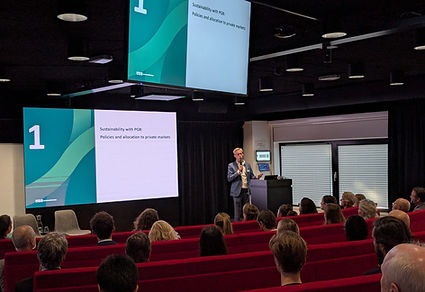impact investing with Private Debt
On the 25th of September, the NAB hosted a breakfast inspiration workshop on Private Debt. Our speakers for this session included Roy Kroon (Pensioenfonds PGB), Henk Groot (Pensioenfonds Detailhandel), Deanne Arends (Achmea IM) and Marjolijn Breeuwer (FMO IM).
Private debt remains a crucial asset class wherein impact, and additionality can be provided with relative ease. But it is not always simple. Our experts took us on a journey of how impact investing looks in private debt from first steps to being an experienced investor.
Kicking-off the workshop, both of the asset owners present, Pensioenfonds PGB and Pensioenfonds Detailhandel, shared that their impact journeys began at the request of their participants. This shows the power of individuals and the path they want to take. The idea of “A good pension in a liveable world” has firmly taken hold.
For PGB mapping before deployment is crucial. Still in their development phase with a sizeable allocation, they start with defined and measurable goals, a focused approach to selected themes and concrete reporting. But impact investing is a journey, and they remain cognisant of this. By starting small and learning on the go, they aim to create a fluent process and create confidence among all stakeholders with collaboration and co-creation.
With already a few steps ahead in their journey after their participants demanded an impact target allocation, Pensioenfonds Detailhandel shared their experience. They walked us through their decision-making process, from revisiting their impact report and investment categories to distinguishing between impact aligned and generating to achieve “real world impact” and avoid impact washing.
Achmea IM highlighted why private debt is well-suited for impact investing, especially for pension funds, citing direct involvement in financing decisions, broad applicability across impact themes, and as important as ever, the presence of market-conform returns. They also provided insights into investable opportunities in private debt and demonstrated how co-creating with the right partners can facilitate impact delivery.
FMO IM brought valuable emerging markets perspective, presenting the reality of risk in developing economies and how it can be navigated effectively. Despite higher perceived risks, their performance remains strong. From FMO's experience, we learned that a solid investment process is key. They showcased portfolio examples demonstrating how thorough due diligence and value creation focus can deliver optimal results.
Following the presentations from our speakers, the extensive Q & A session with the audience raised thought provoking questions.
Key takeaways :
-
Shift in pension fund beneficiaries’ preference: both pension funds present in our panel highlighted their clients’ increasing preference for sustainability and impact.
-
Start small and scale progressively: Successful impact investing requires a learning approach with defined goals and measurable outcomes before significant deployment.
-
Private debt is a well-suited asset class for impact: Unlike investments in public markets, private debt allows for direct influence, with impact requirements treated as strictly as financial covenants, providing more leverage over company behaviour.
-
Pragmatic reporting frameworks: While impact reporting must be rigorous, early adoption of overly strict frameworks can limit investment opportunities. Asset Owners and Asset Managers should adopt a pragmatic approach, finding a balance with their Fund Managers to develop reporting standards without constraining real impact.
-
Risks are perceived as higher: The perception that impact investing is inherently riskier than traditional investing remains a significant barrier, despite evidence suggesting comparable risk-return profiles in most cases. Additionally, risks in EMs are often perceived as higher than they really are. Dissemination of the GEMs database should be wide-spread.
-
Blended finance can offer a solution: Despite its potential to close financing gaps and encourage investments in Emerging Markets, the adoption of blended
The NAB just released a report on Blended Finance, inventorying 21 case studies across 5 blueprints. This report presents a systematic and comparative overview of blended finance can function across fund structures, investment strategies and sectors. See for yourself how blended finance is being mainstreamed across the Netherlands, Europe and EMs.
Watch our webinar on blended finance here with experts from Triodos IM, Better Society Capital and Invest NL.
Moreover, iIn 2023, the NAB launched apublished “Changing Perceptions: An analysis of private debt in emerging markets under Solvency II”. The report showcases with data, that the capital changes for allocation to emerging markets are not excessively hight, dispelling market perception.
For the launch of the report, we hosted a webinar with experts from the field. Watch the webinar here.
You can access the speakers' presentations HERE.



